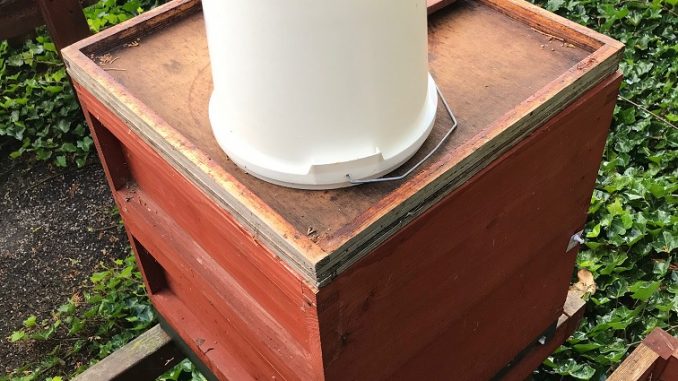
here will be a Zoom session on Tuesday evening, 23rd August at 7.30 pm, to chat over these notes or any other questions you may have. An invitation for the event will be sent out nearer the time and we meet for about an hour; depends on how many questions members put to us.
This hot weather is quite challenging for our colonies as they try to locate water to bring into the hive to help cool it down. Leaving containers with water near to hives helps bees find water as many natural sources have dried up. On the topic of heat some varroa treatments should not be used in high temperatures, e.g. MAQS pads which contains formic acid. Apiguard should be used in warm weather but I am not sure if 30c plus would have an adverse impact on colonies. Do check the instructions if you are using this varroa product.
At the start of September I shall start my winter feeding but carrying out a quick inspection of each colony to see if it looks viable. If there are several frames of brood, some of them containing slabs of sealed brood, I consider the colony in good shape. If it looks dubious the best thing to do is unite it elsewhere. If there are a couple of colonies that are like this I unite them leaving the queens in each box. Let the bees decide which queen they prefer. This only applies to colonies where there are no obvious signs of disease. It also may be necessary to unite colonies if increase has been made earlier in the year due to artificial swarming. Ideally the old queen should be killed and her brood united onto a hive with a current year’s queen. Young queens generally survive the winter better.
In a couple of weeks I shall start feeding and my preference these days is to use Ambrosia. This is an inverted syrup whereas bees need to invert sugar syrup which is more work for them. Ambrosia also keeps for at least a year so can be used in the spring if colonies require a top up before nectar is available. The aim is feed individual colonies as quickly as possible, providing around 20 to 22 kilos of stores for National hive on a single brood box. If using brood and a half or a larger brood box then more stores can be provided. But remember to remove the queen excluder if using brood and a half. I’ve seen a queen die because the bees were in the super with the stores but they could not feed the queen in cold weather. If there are frames with just foundation after the artificial swarm process, bees are reluctant to draw comb late in the season if the frame(s) are by the wall. Move the frames with foundation to either side of the nest which encourages bees to draw them. Don’t place them in the centre of the brood nest as nights can become cold in autumn and brood could become chilled.
An important point to bear in mind is not to overfeed as this will restrict comb space for the queen to lay. The winter bees are raised during the autumn months and if brood frames are full of stores there will not be enough bees raised to maintain the colony over the winter.
The Association stocks Ambrosia so see the latest price list for location of stockists. For autumn feeding I always use syrup not fondant. Fondant is used when the weather is cold, mainly late winter or early spring, as bees won’t process syrup at this time but are happy to tuck into a block of fondant.
My aim is to finish feeding around the end of September as the ivy starts flowering later in the month. Bees don’t seem to overwinter too well if they have a lot of ivy honey in the brood frames. So feeding syrup before the ivy flowers prevents bees storing this honey in the brood box. After feeding I leave one super on the hive for bees to store any ivy they manage to locate which is removed before winter.
